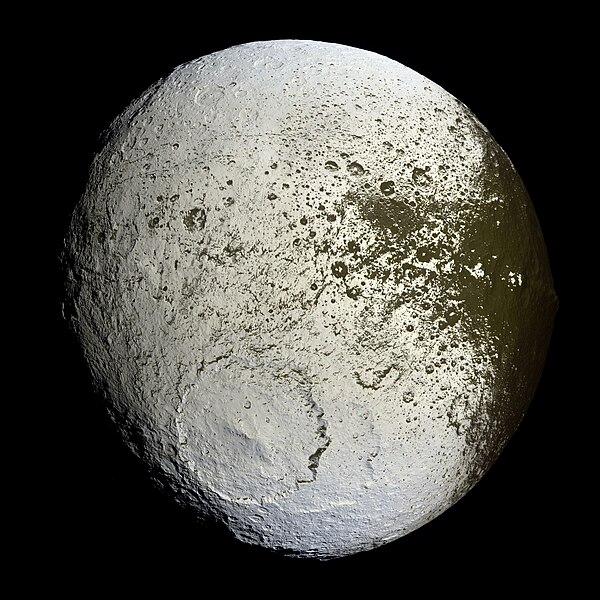Datei:Iapetus as seen by the Cassini probe - 20071008.jpg

Originaldatei (4.032 × 4.032 Pixel, Dateigröße: 6,22 MB, MIME-Typ: image/jpeg)
Diese Datei stammt aus Wikimedia Commons und kann von anderen Projekten verwendet werden. Die Beschreibung von deren Dateibeschreibungsseite wird unten angezeigt.
|

|
Dieses Bild war am 27. Dezember 2007 das Bild des Tages. Es hatte die folgende Beschreibung: Andere Sprachen:
Magyar: A Iapetus, a Szaturnusz egyik holdja, a Cassini űrszonda felvételén hamis színezéssel (NASA/JPL/Space Science Institute) |

|
This image was selected as picture of the day on Vietnamese Wikipedia.
|
Beschreibung
| BeschreibungIapetus as seen by the Cassini probe - 20071008.jpg |
Iapetus as seen by the Cassini probe. |
| Datum | |
| Quelle | PIA08384: The Other Side of Iapetus |
| Urheber | NASA / JPL / Space Science Institute |
| Genehmigung (Weiternutzung dieser Datei) |
PD |
Diese Mediendatei wurde vom Jet Propulsion Lab der US-amerikanischen National Aeronautics and Space Administration (NASA) unter der Datei-ID PIA08384 kategorisiert. Diese Markierung zeigt nicht den Urheberrechtsstatus des zugehörigen Werks an. Es ist in jedem Falle zusätzlich eine normale Lizenzvorlage erforderlich. Siehe Commons:Lizenzen für weitere Informationen. Sprachen:
العربية ∙ беларуская (тарашкевіца) ∙ български ∙ català ∙ čeština ∙ dansk ∙ Deutsch ∙ English ∙ español ∙ فارسی ∙ français ∙ galego ∙ magyar ∙ հայերեն ∙ Bahasa Indonesia ∙ italiano ∙ 日本語 ∙ македонски ∙ മലയാളം ∙ Nederlands ∙ polski ∙ português ∙ русский ∙ sicilianu ∙ slovenščina ∙ Türkçe ∙ українська ∙ 简体中文 ∙ 繁體中文 ∙ +/− |
Lizenz
| Public domainPublic domainfalsefalse |
| Diese Datei ist gemeinfrei (public domain), da sie von der NASA erstellt worden ist. Die NASA-Urheberrechtsrichtlinie besagt, dass „NASA-Material nicht durch Urheberrecht geschützt ist, wenn es nicht anders angegeben ist“. (NASA-Urheberrechtsrichtlinie-Seite oder JPL Image Use Policy). |  | |
 |
Warnung:
|
Kurzbeschreibungen
In dieser Datei abgebildete Objekte
Motiv
8. Oktober 2007
image/jpeg
Dateiversionen
Klicke auf einen Zeitpunkt, um diese Version zu laden.
| Version vom | Vorschaubild | Maße | Benutzer | Kommentar | |
|---|---|---|---|---|---|
| aktuell | 18:07, 12. Dez. 2018 |  | 4.032 × 4.032 (6,22 MB) | wikimediacommons>Kesäperuna | 100% JPEG quality from full quality TIFF, slightly cropped to be more centered. |
Dateiverwendung
Die folgenden 4 Seiten verwenden diese Datei:
